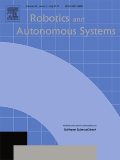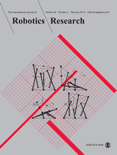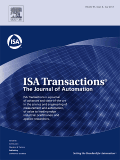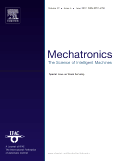
Annual Review of Control Robotics and Autonomous Systems
Scope & Guideline
Pioneering Research in Control and Autonomous Systems
Introduction
Aims and Scopes
- Control Theory and Applications:
The journal emphasizes control methodologies applied in robotics, including adaptive control, reinforcement learning, and model predictive control, which are crucial for the development of autonomous systems. - Human-Robot Interaction and Collaboration:
A core area of focus is on improving human-robot teaming, understanding human intent, and enhancing collaborative efforts in various settings, from military applications to assistive technologies. - Safety and Ethics in Robotics:
The journal addresses the ethical implications and safety concerns associated with robotics, particularly in social and military contexts, highlighting the importance of responsible innovation. - Emerging Technologies in Robotics:
There is a strong emphasis on new technologies, such as soft robotics, microrobotics, and machine learning applications in robotics, reflecting the journal's commitment to exploring cutting-edge advancements. - Energy Systems and Robotics:
The interaction between robotics and energy systems is increasingly significant, with research focusing on control strategies for renewable energy sources and energy-efficient robotic systems.
Trending and Emerging
- Human-Robot Teaming and Collaboration:
Research on human-robot collaboration has surged, addressing the challenges and opportunities of integrating robots into human environments, particularly in high-stakes fields like military and healthcare. - Ethical and Societal Implications of Robotics:
There is a growing emphasis on the ethical considerations of robotics, exploring individual and societal impacts, which is crucial for the responsible deployment of robotic technologies. - Machine Learning and AI in Robotics:
The integration of machine learning techniques in robotics is a rapidly growing area, focusing on improving robot learning, decision-making, and adaptability in complex environments. - Soft Robotics and Bioinspired Systems:
Emerging trends in soft robotics and biomimetic design are gaining traction, reflecting a shift towards more versatile and safer robotic systems that can interact with humans and delicate environments. - Robotics in Energy Management:
The application of robotics in energy systems, particularly renewable energy management and efficiency, is becoming increasingly prominent, aligning with global sustainability goals.
Declining or Waning
- Traditional Industrial Robotics:
Research on traditional industrial robotics has decreased, possibly due to the industry moving towards more collaborative and flexible robotic solutions that integrate advanced AI and machine learning. - Basic Theoretical Frameworks:
There appears to be a waning interest in purely theoretical papers without practical applications, as the journal increasingly favors studies that demonstrate real-world relevance and application. - Static Control Systems:
The focus on static control systems has diminished, as the field shifts towards dynamic, adaptive systems that respond to complex environments and human interactions.
Similar Journals

Artificial Life and Robotics
Exploring the Frontiers of AI and BiochemistryArtificial Life and Robotics, published by Springer, is a prominent journal in the fields of Artificial Intelligence and Biochemistry, Genetics, and Molecular Biology, with an ISSN of 1433-5298 and E-ISSN of 1614-7456. Established in 2005, the journal has continually contributed to knowledge and innovation in these rapidly evolving disciplines and is recognized for its significant impact, as indicated by its quartile rankings in the 2023 category assessments. The journal is currently positioned in Q4 for Artificial Intelligence and Q3 for General Biochemistry, Genetics and Molecular Biology, with a notable ranking of 138/221 and 262/350 in respective research areas. While it currently does not follow an open access model, it remains a valuable resource for researchers, professionals, and students seeking to advance their understanding and application of artificial life and robotic technologies. With an emphasis on interdisciplinary research, this journal aims to bridge theoretical foundations with practical applications, making it an essential platform for cutting-edge studies and discussions in the field.

Studies in Informatics and Control
Exploring Cutting-Edge Research in TechnologyStudies in Informatics and Control is a distinguished academic journal published by the NATL INST R&D INFORMATICS-ICI, specializing in the interdisciplinary fields of Computer Science and Electrical and Electronic Engineering. With an ISSN of 1220-1766 and a recognized standing within its field, this journal aims to foster innovation and disseminate high-quality research findings from 2010 through 2024. It maintains a significant presence in the academic landscape, holding a Q3 ranking in both Computer Science (miscellaneous) and Electrical and Electronic Engineering categories for 2023, which underscores its commitment to advancing knowledge and technology in these areas. While the journal is not open access, it provides valuable insights and results that are essential for researchers, professionals, and students striving to develop their expertise in informatics and control systems. Based in Romania, its contributions traverse international boundaries, appealing to a global audience keen on the latest developments and trends within these rapidly evolving fields.

ROBOTICS AND AUTONOMOUS SYSTEMS
Transforming Ideas into Intelligent Solutions.ROBOTICS AND AUTONOMOUS SYSTEMS, published by Elsevier, is a leading journal in the fields of robotics and automation, providing a platform for the dissemination of high-quality, peer-reviewed research. With an impressive impact factor and a prestigious reputation, this journal is classified in the Q1 category for major fields including Computer Science Applications, Control and Systems Engineering, Mathematics, and Software as of 2023. The journal boasts an extensive archive dating back to 1988, reflecting the evolution of the discipline and fostering innovative research discussions that are crucial for advancements in autonomous technologies. Researchers, professionals, and students are encouraged to contribute to and benefit from the ongoing dialogue within these dynamic fields. Accessible through various academic resources, ROBOTICS AND AUTONOMOUS SYSTEMS stands as a pivotal information source for those dedicated to exploring the frontiers of intelligent systems.

INTERNATIONAL JOURNAL OF ROBOTICS RESEARCH
Transforming Theoretical Concepts into Practical ApplicationsINTERNATIONAL JOURNAL OF ROBOTICS RESEARCH (ISSN: 0278-3649, E-ISSN: 1741-3176), published by SAGE PUBLICATIONS LTD, is a leading journal in the fields of robotics and engineering. With an impressive impact factor and recognized as a Q1 journal in various categories including Applied Mathematics, Artificial Intelligence, Electrical and Electronic Engineering, Mechanical Engineering, Modeling and Simulation, and Software, it has established itself as an essential resource for researchers and practitioners alike. The journal covers a wide array of topics relevant to the advancing disciplines of robotics, ensuring comprehensive perspectives on both theoretical and practical applications. Notably, it ranks at the top percentile in Scopus rankings across multiple fields, which underscores its significance in the research community. Published continuously since 1982, the journal invites submissions that push the boundaries of robotics research, offering a platform for innovative ideas and solutions that address complex engineering problems. While it operates under a subscription model, its vast reach and reputation make it an invaluable resource for advancing knowledge in robotics.

INTERNATIONAL JOURNAL OF ROBOTICS & AUTOMATION
Pioneering Research in Robotics and Automation.International Journal of Robotics & Automation is a premier academic journal published by ACTA PRESS, dedicated to advancing knowledge and applications in the dynamic fields of robotics, automation, and related engineering disciplines. With a history spanning from 1995 to 2024, this journal serves as a crucial platform for the dissemination of innovative research, offering valuable insights across various categories, including Artificial Intelligence, Control and Systems Engineering, and Mechanical Engineering. Although currently not open access, its rigorous peer-reviewed articles hold significance for researchers, professionals, and students alike, providing a solid foundation for advancements in technology and engineering methodologies. The journal's rankings in Scopus reflect its growing impact, particularly in niche areas of Modeling and Simulation and Software, highlighting the critical need for cutting-edge research and discussion in these developing fields. As the landscape of robotics and automation continues to evolve, this journal remains an essential resource for those seeking to contribute to and engage with the forefront of scholarly research.

AUTONOMOUS ROBOTS
Pioneering the Future of Robotics Innovation.AUTONOMOUS ROBOTS, published by SPRINGER, is a leading academic journal that serves as a pivotal platform for the dissemination of cutting-edge research in the field of Autonomous Robotics. With an ISSN of 0929-5593, this esteemed journal has been at the forefront of innovation since its inception in 1994, and it continues to thrive with a vision extending to 2024 and beyond. Recognized in the Q1 category of Artificial Intelligence, it boasts a commendable ranking of #85 out of 350 in Computer Science and Artificial Intelligence, positioning it within the 75th percentile of researchers' preferred publications. The journal features a range of subjects related to autonomous systems, including but not limited to robot perception, action planning, multi-agent systems, and autonomous interactions, catering to an audience that spans researchers, industry professionals, and students alike. Scholars can access a wealth of peer-reviewed articles that contribute to both theoretical frameworks and practical applications, ensuring the relevance of the work published within its pages. Located in Dordrecht, Netherlands, AUTONOMOUS ROBOTS exemplifies a commitment to advancing the science of robotics, making significant contributions to the knowledge base and inspiring new developments within the field.

Intelligent Service Robotics
Exploring Frontiers: Bridging AI and Robotics for a Smarter WorldIntelligent Service Robotics, published by SPRINGER HEIDELBERG, is a leading journal that focuses on the transformative intersection of intelligent systems and robotics, establishing itself as a pivotal resource for researchers, professionals, and students in the fields of Artificial Intelligence, Computational Mechanics, and Mechanical Engineering. With an impressive impact factor reflective of its relevance—featuring a 2023 Q1 ranking in Computational Mechanics and Mechanical Engineering, and Q2 in Artificial Intelligence—this journal disseminates high-quality, peer-reviewed research that propels innovation and application in various engineering disciplines. Operating from its headquarters in Heidelberg, Germany, Intelligent Service Robotics aims to foster a dynamic academic community, encouraging open dialogue and collaboration among thought leaders and emerging scholars alike. The journal invites submissions that provide novel insights and solutions in the rapidly evolving landscape of service robotics, ensuring that it remains at the forefront of scientific discourse. With a converged publication timeline from 2008 to 2024 and robust Scopus rankings, the journal is committed to shaping the future of robotic intelligence and its applications.

ISA TRANSACTIONS
Connecting Theory with Practice in Engineering DisciplinesISA TRANSACTIONS, published by Elsevier Science Inc, is a premier academic journal that serves as a vital platform for advancing knowledge in the fields of Applied Mathematics, Computer Science Applications, Control and Systems Engineering, Electrical and Electronic Engineering, and Instrumentation. With an impressive H-index reflecting its scholarly impact, the journal is recognized in the top quartile (Q1) across its categories as of 2023, showcasing its significance within these disciplines. The journal boasts a robust Scopus ranking, placing it amongst the top journals globally—ranked #16 in Applied Mathematics and #6 in Instrumentation—highlighting its influence and reputation. ISA TRANSACTIONS not only contributes to theoretical advances but also addresses practical applications in engineering and technology, making it essential reading for researchers, professionals, and students seeking to stay at the forefront of innovation. Published continuously since 1968, it promises to remain a cornerstone for future research until at least 2024, fostering academic discourse and collaboration in a rapidly evolving technical landscape.

MECHATRONICS
Unveiling Cutting-Edge Research in Mechatronic SystemsMECHATRONICS is a prominent journal published by PERGAMON-ELSEVIER SCIENCE LTD, focusing on the interdisciplinary fields of mechanical engineering, control and systems engineering, electrical and electronic engineering, and computer science applications. With an ISSN of 0957-4158, this journal has been a cornerstone in advancing knowledge and innovation since its inception in 1991. Known for its rigorous peer-review process and high-quality research outputs, MECHATRONICS holds prestigious rankings, including Q1 in both Electrical and Electronic Engineering and Mechanical Engineering for the year 2023, reflecting its influential position in the academic community. The journal caters to a diverse audience of researchers, professionals, and students, making it an essential resource for those looking to stay at the forefront of technological advancements in mechatronic systems. Although it does not currently offer open access, its wealth of insights and findings is indispensable for anyone pursuing excellence in engineering methodologies and applications.

Industrial Robot-The International Journal of Robotics Research and Application
Leading the Charge in Robotics Research ExcellenceIndustrial Robot-The International Journal of Robotics Research and Application is a premier academic journal published by Emerald Group Publishing Ltd in the United Kingdom. Since its inception in 1973, the journal has established itself as a critical resource for the advancement of knowledge in the fields of robotics and automation. With an impressive Q2 ranking across several categories, including Computer Science Applications, Control and Systems Engineering, and Industrial and Manufacturing Engineering, it places itself among the top-tier journals in its domain. The journal aims to disseminate high-quality research that addresses contemporary challenges and innovations in robotics, thereby supporting both academic inquiry and practical applications in industry. Researchers, professionals, and students are encouraged to contribute to its mission, as it remains vital for those seeking to engage with the ever-evolving landscape of robotic technologies.